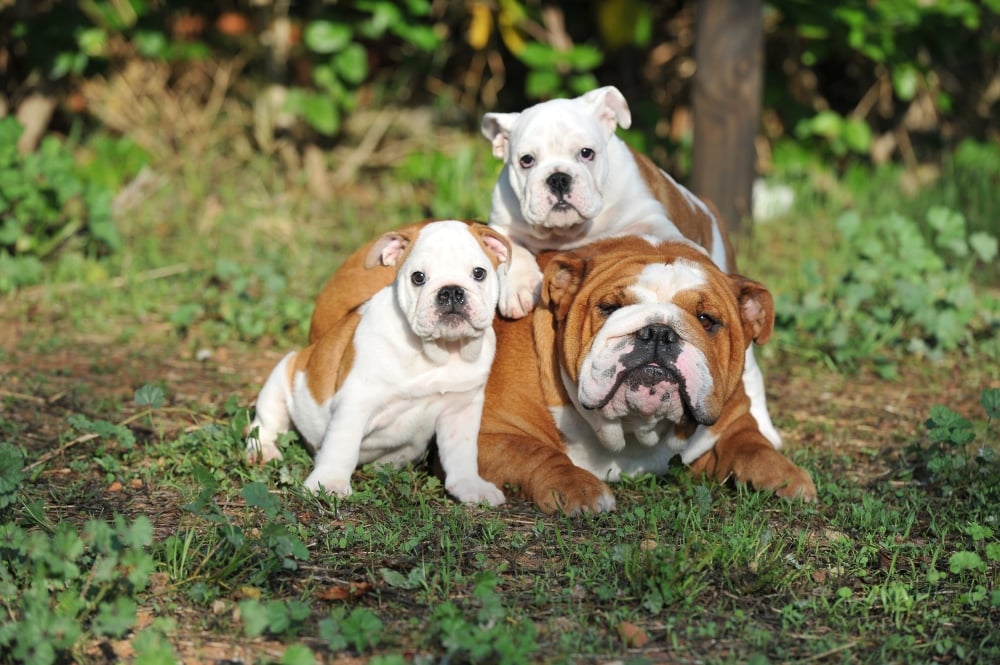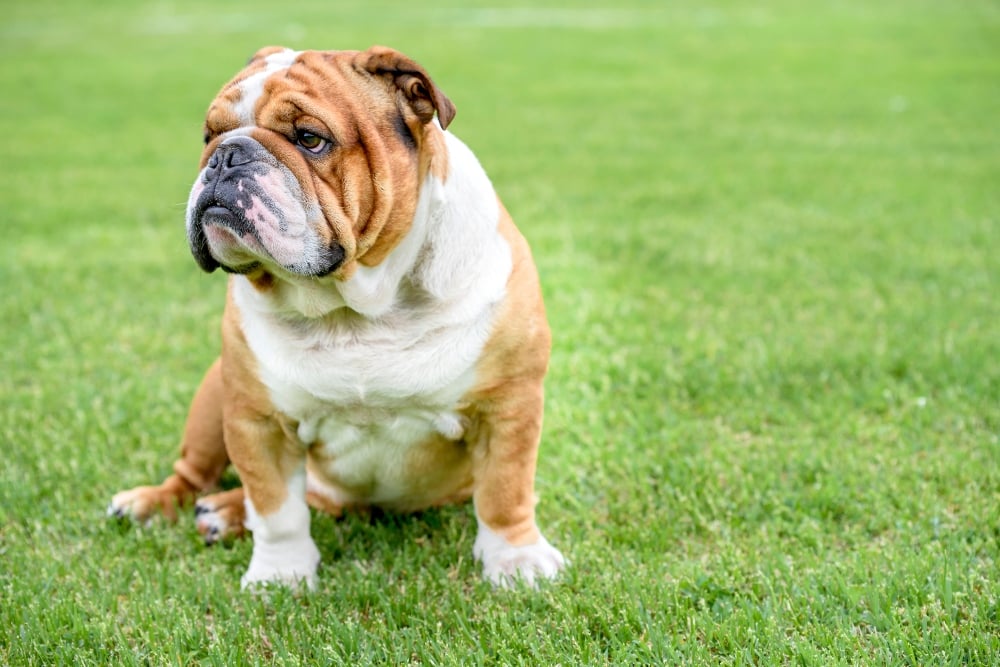Introduction to English Bulldogs
The English bulldog is a Non-Sporting Group dog that is calm, friendly, and muscular. It has become a symbol of courage and tenacity while also being a well-known loyal companion for town or country life. This is a medium-sized breed of dog that is wide, compact and has short legs. These dogs have a sweet disposition and make wonderful family dogs since they are predictable and gentle with children. With a big head, facial wrinkles, and a stocky build, English bulldogs are instantly recognizable and loved all around the world.
If you are curious to learn more about English bulldogs and how to take the best care of them, you’re in the right place with our English bulldog breed guide!
Size of English Bulldogs
When fully grown, a male English bulldog should weigh about 50 pounds, and a female English bulldog should weigh about 40 pounds. Both males and females will stand approximately 14 to 15 inches tall as adults. English bulldogs are considered fully grown when they reach one year of age; however, some dogs will continue growing a bit more until they are closer to a year and a half old.
Here’s how big you can expect your English bulldog to get during the first year of life:
| Weight Chart | 3 months | 6 months | 9 months | 12 months |
| Male and Female English Bulldogs – Average Weight | 12-18 pounds | 26-37 pounds | 35-47 pounds | 40-50 pounds |
Characteristics of English Bulldogs
English bulldogs may look a bit intimidating based on appearance alone, but there’s more to these dogs than meets the eye. They have a reputation for being determined and bull-headed, but this also just means that they don’t give up easily and make good watchdogs. Bulldogs love human affection and are very happy spending lazy days on the couch or sitting at your feet.
Interestingly, English bulldogs exhibit alpha canine behaviors and do not see themselves as followers. Therefore, they need a kind but strong human leader to keep the household balance in check. Other unique characteristics of English bulldogs are that they tend to drool and snore, are messy eaters, and may exhibit guarding behaviors with toys and food.
As you get to know an English bulldog’s personality, here’s what you can expect based on his or her breed characteristics:
| Breed Characteristic | Level (High, Medium, Low) |
| Affectionate with People | High |
| Good with Kids | High |
| Good with Pets | High |
| Need for Exercise | Low |
| Energy Level | Low |
| Intelligence Level | Medium |
| Able to Be Trained | Medium |
| Amount of Barking | Low |
| Amount of Shedding | Medium |

History of English Bulldogs
The history of the English bulldog dates back to around the 13th century in England, during the reign of King John. At that time, the dogs were used in the sport of bullbaiting, which involved making a pack of dogs and a bullfight while spectators bet on who would win. These early ancestors of the English bulldog breed were bred to have huge jaws and be very brave, even when up against formidable adversaries.
Fortunately, blood sports with animals were banned in England in 1835. Yet the sport moved underground as an illicit activity, and other bull-type terrier breeds emerged for fighting purposes. With time, the English bulldog became seen as a companion rather than a fighter, especially as breeders focused on making these dogs mellower and sweeter.
The American Kennel Club began recognizing the English bulldog as an official breed in 1886, and the dog has been named a national symbol of England. Many sports teams in America use the bulldog as their mascot, and numerous companies use bulldogs on their logos to show a sense of courage and strength.
English Bulldog Standard Information
The breed standard for the English bulldog serves as an ideal by which these dogs are judged at shows and competitions. For example, the general appearance of an English bulldog includes having a medium size, smooth coat, massive head, wide shoulders, and sturdy limbs. The disposition of an English bulldog should be kind, courageous, resolute, dignified, and pacific.
Here is an overview of the breed standard information for English bulldogs:
Head:
- Eyes situated low down in skull
- Ears set high in the head
- Very large head
- Well-rounded cheeks
- Large, broad, and black nose
- Very short muzzle
- Large and strong teeth
- Massive and broad jaws
Neck, Topline, Body:

- Short, very thick, deep, and strong neck
- Slight fall in the back
- Very capacious brisket and body
- Tail either straight or screwed
Forequarters:
- Muscular and very stout forelegs
- Elbows low and loose from the body
- Feet moderate in size
- Toes compact and well split up
Hindquarters:
- Hind legs strong and slightly longer than forelegs
- Hocks slightly bent and well let down
- Hind feet pointed well outward
Coat:
- Coat should be straight, short, flat, close, fine, smooth, and glossy
- Skin should be soft and loose
- Face and head covered with heavy wrinkles
Color:
- Uniform color that is pure and brilliant
- Red, white, fawn, fallow, or any combination of these
- Patterns are brindle, piebald, ticking, black masks, and black tipping
Gait:
- Loose-jointed, shuffling, and sidewise motion
- Characteristic “roll” motion
- Action is unrestrained, free, and vigorous
Caring for English Bulldogs
Even though English bulldogs are medium-sized dogs, they do well in apartments and do not need a large yard to run around in. They are low-endurance dogs that only require moderate exercise to be healthy.
These dogs often have trouble breathing and can overheat quickly when the weather is hot. They are noisy breathers in general and often wheeze and snore even when they are resting. These are all important things to know before introducing an English bulldog into your current living situation.
Here are some general tips for taking the best care of an English bulldog:
Best Living Environments:
- Do fine in apartments and don’t need a large yard
- Should not be outside unsupervised in hot or cold weather
- Prefer a relaxed lifestyle that is not too active
- Air conditioning during the summer
Type of Exercise:
- Go on moderately-paced walks every day
- No strenuous exercise
- No swimming because their large heads make them sink in water
Mental Enrichment:
- Plenty of relaxing time with family members
- Exploring sights and smells around the neighborhood
- Offer durable chew toys
- Food puzzles
Training Strategies:
- Not the most trainable dogs but lessons can be learned
- Make training sessions fun with rewards and praise
- Train dogs to not be overprotective of food and toys
- Positive reinforcement not punishment
- Reward with small treats and a kind voice
Grooming Tips:
- Brush coat once per week with a firm bristle brush
- Wipe face daily with a clean, damp cloth
- Make sure wrinkles are dry after washing the face
- Brush teeth daily
- Trim nails once or twice per month

Common Health Problems of English Bulldogs
You can expect the average English bulldog to live for about eight to 10 years. Help your English bulldog live a full and happy life by keeping up with regular vet checkups and signing your dog up for a pet insurance plan with Healthy Paws.
These are some of the most common health issues that arise with English bulldogs:
- Brachycephalic syndrome
- Heatstroke
- Cherry eye, dry eye
- Entropion (eyelashes turn inward)
- Idiopathic head tremor syndrome (involuntary head shaking)
- Skin problems
- Bladder stones
- Gastric dilatation and volvulus
- Dental problems
- Patellar luxation
- Hip dysplasia
Diet and Nutrition for English Bulldogs
English bulldogs love to eat and are often messy eaters. Pet parents will need to carefully watch their dogs’ intake of food and treats to prevent overeating and obesity, which can lead to many different medical issues. An obese English bulldog is more prone to joint pain and heart conditions, for example. Make sure you feed meals rather than leaving food out throughout the day.
Feed the amount of dog food needed to keep your pet slim. You should be able to see your English bulldog’s waist and feel (but not see) the ribs without having to press too hard. Divide the total amount of food for the day into at least two meals for adults and three to five meals for puppies.
Limit the number of treats you give to help keep your dog’s weight under control. Although treats can be useful during training sessions, limit high-calorie treats and only use treats sparingly when working with an English bulldog.
Most adult English bulldogs will thrive when eating a high-quality, nutritionally complete and balanced adult dog food. Puppies should eat puppy food until they are around 12 months old. If you feed your English bulldog homemade dog food, make sure you are working from a recipe that is designed by a veterinary nutritionist and that is appropriate for your dog’s age and health status. Recommended foods for English bulldogs include Canidae Life Stages Dog Food, Earthborn Holistic Great Plains Feast Grain-Free Dry Dog Food, and Artemis Fresh Mix Adult Dog Food.
Good nutrition is very important for English bulldogs to live long and happy lives. Talk to your veterinarian if you have any questions about your dog’s diet or health.
Where to Adopt or Purchase English Bulldogs
The Bulldog Club of America is the national breed club for this dog and a resource for finding a responsible breeder or entering your dog into a competition. However, there are many canine rescue groups that focus on bulldog rescues, such as the Bulldog Rescue Network, Austin Bulldog Rescue, So Cal Bulldog Rescue, and Georgia English Bulldog Rescue. To familiarize yourself with this breed and how one of these dogs might fit into your life, you might consider fostering an English bulldog before adopting or purchasing one or volunteering at a bulldog-specific rescue organization.
Related Breeds
If you love the idea of having an English bulldog as a companion but aren’t totally convinced that this is the right breed for you, it may be beneficial to learn about other similar and related dog breeds, such as these:
- Bull terrier
- French bulldog
- Bullmastiff
- American Staffordshire Terrier
Pet Insurance for English Bulldogs
Since English bulldogs are prone to many health conditions due to their genetics and breeding, many pet parents choose to get pet insurance for their pups so that they are prepared for anything and everything. Pet insurance through Healthy Paws offers flexible premium and deductible options, has no costly add-ons, and lets you use any licensed veterinarian you choose.
If your English bulldog suffers from an injury or gets sick, simply submit your vet bill to us on our website or app, and we’ll get your claim processed quickly so you can focus on getting your pup to feel well again. Get your English bulldog pet insurance quote from Healthy Paws today!









